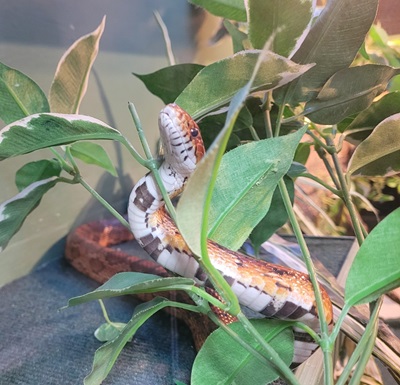
Our Animal of the Month for August wants to get an early start on the Labour Day weekend so it’s time t0 bid a fond farewell to the corn snake. We hope that you enjoyed following us on “X” (a.k.a. Twitter) and Threads as we posted all month long about these popular snakes. But you can always find a summary of our posts right here on our blog that you can reference anytime. Did you know?:
- In the wild, corn snakes (Pantherophis guttatus) are endemic to parts of the eastern U.S. with their range stretching from southern New Jersey down to Florida.
- Corn snakes can also be found in parts of some neighbouring states just to the west of those aforementioned eastern states, including Alabama, Mississippi, Louisiana, Tennessee and Kentucky.
- There have been reports of introduced corn snake populations on a number of Caribbean islands; including the U.S. Virgin Islands, the Bahamas, Grand Cayman and the Lesser Antilles.
- In the wild, corn snakes can be found in a wide variety of habitats; including pine and deciduous forests, grasslands, rocky areas, fields and in agricultural areas – both in and around barns.
- While they generally prefer lower elevations, there are reports of corn snakes being found in some mountainous areas up to 1,800 metres in elevation.
- Corn snakes like to burrow and are considered to be semi-fossorial, which means they can – and do – live under rocks, logs and leaves.
- Corn snakes are medium-sized and slender with adults reaching average lengths of between three and six feet (0.9 – 1.82 metres).
- Their natural colour is orangey-red or brownish with reddish blotches edged in black on their backs. Because of their colouring, corn snakes are sometimes known as red corn snakes or red rat snakes.
- Corn snakes have alternating black and white marks all along their bellies, which can be described as being in a checkerboard pattern.
- Captive breeding of corn snakes for the pet trade has resulted in a wide variety of colour morphs and patterns. There are reportedly hundreds of documented corn snake morphs.
- Despite their name, corn snakes don’t eat corn. They are true carnivores just like every other snake species.
- In the wild, corn snakes will eat small rodents, such as mice and rats. They will also eat unattended bird eggs, small birds, lizards, frogs and bats.
- If they’re not made of corn and they don’t eat corn, then why are they called corn snakes?
- There are a couple of theories as to why the corn snake is so named. One stems from the snakes preying on rodents who feast on harvested corn stores.
- Another theory is that corn snakes get their name from the distinct checkerboard pattern on their bellies, which some say resemble Flint corn (a.k.a. calico corn).
- Birds of prey, foxes, weasels, bobcats, skunks and opossums predate on corn snakes in the wild.
- But humans, by far, represent the biggest threat to wild corn snakes through habitat destruction and fear-based killing.
- Humans often confuse corn snakes in the wild for the venomous copperhead snake (Agkistrodon contortix) and will kill them as a result of this mistaken identity. But corn snakes are not venomous and are harmless to humans.
- Corn snake populations were also once under threat by humans plucking them out of the wild for the pet trade. But widespread captive breeding has largely solved this problem.
- In the wild, corn snake breeding season typically occurs between March and May.
- After mating, the gestation period lasts about two months. Then, between late May and July, the female will lay a clutch of between 10 and 30 eggs in warm and humid secluded burrows, stumps or logs.
- The female corn snake’s parental obligations end when she lays her last egg. The eggs will incubate unattended for about two months and will hatch between July and September. The hatchlings are on their own as soon as they hatch.
- Corn snakes in the wild have an expected average lifespan of 6-8 years.
- With proper care in captivity, corn snakes can live much longer with an average lifespan of 15-20 years. Although it’s not uncommon for them to live comfortably into their 20s.
- Several sources say the oldest corn snake on record lived to be 32 years and three months.
This is the second time that we have featured corn snakes as our Animal of the Month. The first time was exactly 10 long years ago! Come on over to our blog post from August 2014 to see what we posted about corn snakes then!

